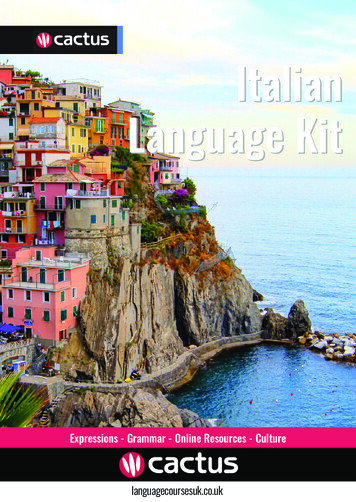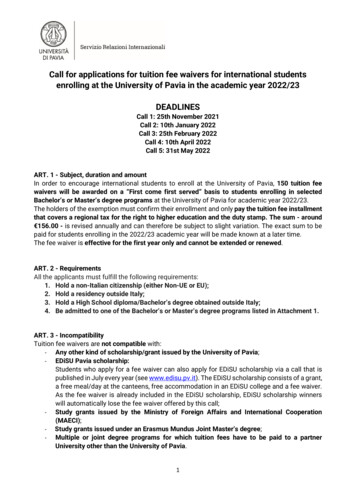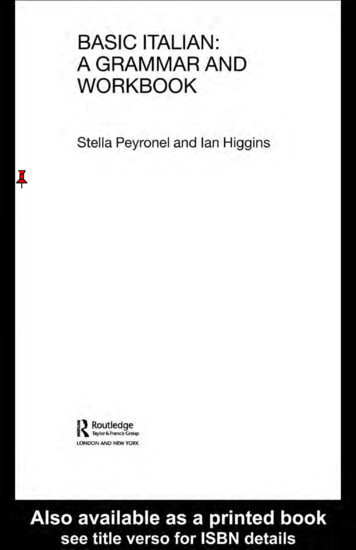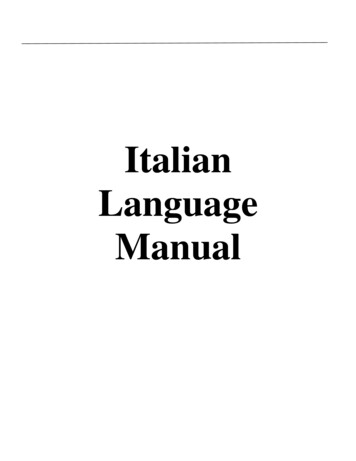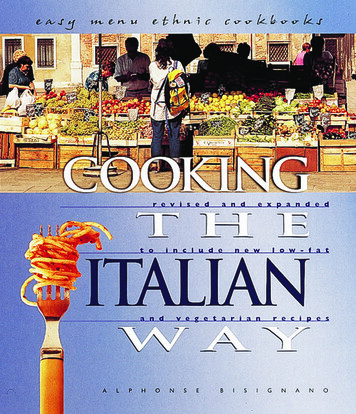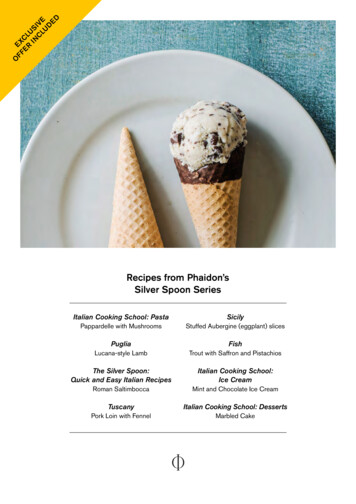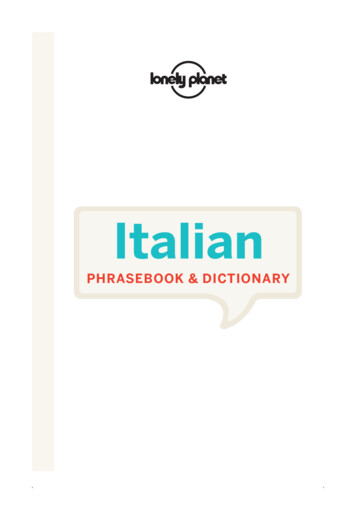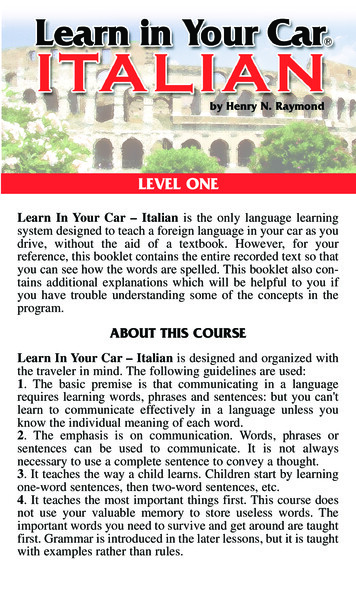
Transcription
by Henry N. RaymondLEVEL ONELearn In Your Car – Italian is the only language learningsystem designed to teach a foreign language in your car as youdrive, without the aid of a textbook. However, for yourreference, this booklet contains the entire recorded text so thatyou can see how the words are spelled. This booklet also contains additional explanations which will be helpful to you ifyou have trouble understanding some of the concepts in theprogram.ABOUT THIS COURSELearn In Your Car – Italian is designed and organized withthe traveler in mind. The following guidelines are used:1. The basic premise is that communicating in a languagerequires learning words, phrases and sentences: but you can'tlearn to communicate effectively in a language unless youknow the individual meaning of each word.2. The emphasis is on communication. Words, phrases orsentences can be used to communicate. It is not alwaysnecessary to use a complete sentence to convey a thought.3. It teaches the way a child learns. Children start by learningone-word sentences, then two-word sentences, etc.4. It teaches the most important things first. This course doesnot use your valuable memory to store useless words. Theimportant words you need to survive and get around are taughtfirst. Grammar is introduced in the later lessons, but it is taughtwith examples rather than rules.
5. No more than one new word is introduced at a time. Thismeans you won't hear a sentence or a phrase and wonder whichsound corresponds to which word.6. No textbook is required. The fact that no more than one newword is introduced at a time enables you to use the CDseffectively without referring to a textbook. The CDs aredesigned to be used without a textbook so that you can usethem while driving a car or while doing other things thatrequire similar amounts of concentration.7. Literal (word-for-word) translations are used as much aspossible. This enables you to understand how a sentence orphrase is constructed and what the individual words mean.HOW TO USE“LEARN IN YOUR CAR – ITALIAN”The first track on the first disk is an introduction. Lessons starton the following track.Start by playing through Lesson One. For each expression youwill hear the English version followed by a pause, then theItalian translation followed by a pause, then the Italiantranslation a second time followed by a third pause. At first,you will only be able to imitate the Italian words in the twopauses after the Italain translations (the second and third pauses). As you learn and progress, you will be able to recall andrecite the Italian version during the first pause before you hearthe first Italian translation. Be sure to speak the Italian expressions out loud. The rate at which you learn will be significantly slower if you do not speak the expressions aloud.Play Lesson One several times until you learn most of it. Thenstart playing Lesson One followed by Lesson Two until youlearn most of Lesson Two. As you progress, keep addinglessons. Always go back to the beginning of Lesson One toreinforce the material you have already learned. (As youprogress through the material, you may want to restart at someplace other than the start of Lesson One. This is fine as long asyou know all the material ahead of your starting point. Laterlessons are designed with the assumption that you alreadyknow the material in earlier lessons.)
NOTES ABOUT THE TEXT Words that are underlined in phrases in the text have the samemeaning in both English and Italian. When a new word isintroduced, it will usually be underlined. Literal translations are in brackets with an "L." such as:[L. This is a literal translation.] Words in brackets [like this] are understood, but are not heardon the recording.NOTES ABOUT THE CDs The disc and track numbers for each lesson are listed in theTable of Contents.ACKNOWLEDGMENTSI would like to thank Gloria Grandini, Francesco Catori, JohnCarbone, Ester Martinelli, Rosanna Ferraro, Annette Norrisand Linda Rabin who helped to make this audio productionpossible.—Hank RaymondPublished and distributed byPenton Overseas, Inc., 2005, 1994 Penton Overseas. All rights reserved.
TABLE OF CONTENTSDisc 1: Tracks 1-161: Introduction and Instructions2: Lesson 1 Basics3: Lesson 2 Basic Phrases4: Lesson 3 Transportation Nouns5: Lesson 4 Transportation Phrases6: Lesson 5 Money7: Lesson 6 Hotel8: Lesson 7 Important Words9: Lesson 8 Directions10: Lesson 9 Numbers11: Lesson 10 More Numbers12: Lesson 11 Big Numbers13: Lesson 12 Very Big Numbers14: Lesson 13 At the Restaurant15: Lesson 14 Shopping16: Lesson 15 Time, GeneralDisc 2: Tracks 1-131: Introduction2: Lesson 16 Time of Day3: Lesson 17 Questions4: Lesson 18 Shops5: Lesson 19 Nouns6: Lesson 20 Adjectives and Adverbs7: Lesson 21 Verbs8: Lesson 22 Prepositions9: Lesson 23 Prepositional Pronouns10: Lesson 24 Possessive Adjectives11: Lesson 25 Conjunctions and Similar Words12: Lesson 26 Sentences and Phrases, General13: Lesson 27 Sentences and Phrases, NegativeDisc 3: Tracks 1-161: Introduction2: Lesson 28 Forming Questions3: Lesson 29 Sentences and Phrases, General4: Lesson 30 Sentences and Phrases, Transportation5: Lesson 31 Sentences and Phrases, Money6: Lesson 32 Sentences and Phrases, Hotel7: Lesson 33 Sentences and Phrases, Getting Around8: Lesson 34 Sentences and Phrases, Directions9: Lesson 35 Sentences and Phrases, Conversation10: Lesson 36 Sentences and Phrases, Internet11: Lesson 37 The Verb “Essere” (to be), Present Tense12: Lesson 38 The Verb “Avere” (to have), Present Tense11: Lesson 39 Typical Regular Verb with “are” Ending, Present Tense12: Lesson 40 Typical Regular Verb with “ere” Ending, Present Tense
LESSON 1 – LEZIONE 1BASICS – ELEMENTI BASILARII . . . . . . . . . . . . . . . . . . . . . . . . . . . . . . . . . . . . . . . . . . . . . . . . . ioyou (familiar) . . . . . . . . . . . . . . . . . . . . . . . . . . . . . . . . . . . . . . tuyou (polite) . . . . . . . . . . . . . . . . . . . . . . . . . . . . . . . . . . . . . . . . Leihe . . . . . . . . . . . . . . . . . . . . . . . . . . . . . . . . . . . . . . . . . . . . . . . . luishe . . . . . . . . . . . . . . . . . . . . . . . . . . . . . . . . . . . . . . . . . . . . . . . leithis . . . . . . . . . . . . . . . . . . . . . . . . . . . . . . . . . . . . . . . . . . . . . . . questo [masc.] / questa [fem.]We . . . . . . . . . . . . . . . . . . . . . . . . . . . . . . . . . . . . . . . . . . . . . . . noiyou (plural, as in “you guys” or “you people”) . . . . . . . . . . . . voithey . . . . . . . . . . . . . . . . . . . . . . . . . . . . . . . . . . . . . . . . . . . . . . lorogood morning / good day . . . . . . . . . . . . . . . . . . . . . . . . . . . . . buon giornogood evening . . . . . . . . . . . . . . . . . . . . . . . . . . . . . . . . . . . . . . buona seragood night . . . . . . . . . . . . . . . . . . . . . . . . . . . . . . . . . . . . . . . . . buona nottegood-bye . . . . . . . . . . . . . . . . . . . . . . . . . . . . . . . . . . . . . . . . . . arrivedercihello / good-bye . . . . . . . . . . . . . . . . . . . . . . . . . . . . . . . . . . . . ciaoplease . . . . . . . . . . . . . . . . . . . . . . . . . . . . . . . . . . . . . . . . . . . . per favore / per piacerethank you . . . . . . . . . . . . . . . . . . . . . . . . . . . . . . . . . . . . . . . . . grazieyou’re welcome / please . . . . . . . . . . . . . . . . . . . . . . . . . . . . . . pregoyes . . . . . . . . . . . . . . . . . . . . . . . . . . . . . . . . . . . . . . . . . . . . . . . sì1
no . . . . . . . . . . . . . . . . . . . . . . . . . . . . . . . . . . . . . . . . . . . . . . . nogood . . . . . . . . . . . . . . . . . . . . . . . . . . . . . . . . . . . . . . . . . . . . . buonobad . . . . . . . . . . . . . . . . . . . . . . . . . . . . . . . . . . . . . . . . . . . . . . . cattivosir / Mr. . . . . . . . . . . . . . . . . . . . . . . . . . . . . . . . . . . . . . . . . . . signore / signormadam / Mrs. . . . . . . . . . . . . . . . . . . . . . . . . . . . . . . . . . . . . . . signoramiss . . . . . . . . . . . . . . . . . . . . . . . . . . . . . . . . . . . . . . . . . . . . . . signorina“tu” familiar “you” singular, used in casual conversation.“Lei” polite “you” used with strangers or to be polite.“voi” familiar and polite “you” plural as in “you guys” or “you all.” This form is used as a plural for both“tu” and “Lei.”“Lei” (polite “you”) is often capitalized to distinguish it from “lei” (she), but it is not necessary.The pronoun “Loro” (capitalized) is also used as a very formal “you” plural, however this usage is very rarein modern Italian.The subject pronoun “it” is almost never used in Italian. Instead, a sentence will simply start with a verb.The subject pronoun “it” is implied by the form (conjugation) of the verb that is used along with the contextof the rest of the sentence.LESSON 2 – LEZIONE 2BASIC PHRASES – LOCUZIONI DI BASEI want. . . . . . . . . . . . . . . . . . . . . . . . . . . . . . . . . . . . . . . . . . . . Io voglio.2
I don’t want. . . . . . . . . . . . . . . . . . . . . . . . . . . . . . . . . . . . . . . . Io non voglio.Where? . . . . . . . . . . . . . . . . . . . . . . . . . . . . . . . . . . . . . . . . . . . Dove?Where is? / Where is it? . . . . . . . . . . . . . . . . . . . . . . . . . . . . . . Dov’è?Where is the toilet? / Where is the bathroom? . . . . . . . . . . . . . Dov’è il bagno?How much? . . . . . . . . . . . . . . . . . . . . . . . . . . . . . . . . . . . . . . . . Quanto?How much does it cost? [L. How much costs?] . . . . . . . . . . . Quanto costa?time / hour . . . . . . . . . . . . . . . . . . . . . . . . . . . . . . . . . . . . . . . . . ora what time? / which hour? . . . . . . . . . . . . . . . . . . . . . . . . . che ora?At what time? . . . . . . . . . . . . . . . . . . . . . . . . . . . . . . . . . . . . . . A che ora?You have (polite) . . . . . . . . . . . . . . . . . . . . . . . . . . . . . . . . . . . . Lei ha Do you have ? [L. Have [you] ?] (polite) . . . . . . . . . . . . . . Ha ?I understand. . . . . . . . . . . . . . . . . . . . . . . . . . . . . . . . . . . . . . . . Io capisco.I don’t understand. . . . . . . . . . . . . . . . . . . . . . . . . . . . . . . . . . . Io non capisco.Do you understand? (polite) . . . . . . . . . . . . . . . . . . . . . . . . . . . Lei capisce?It is . . . . . . . . . . . . . . . . . . . . . . . . . . . . . . . . . . . . . . . . . . . . É Is it ? . . . . . . . . . . . . . . . . . . . . . . . . . . . . . . . . . . . . . . . . . . . É ?Subject pronouns (io, tu, lui, lei, Lei, noi, voi, loro, Loro) generally are not required to be used in sentences.This is because the subject pronoun can be determined by simply observing which form or conjugation ofthe verb is used. (i.e. The verb will change depending on which subject pronoun is being referred to.)3
LESSON 3 – LEZIONE 3TRANSPORTATION NOUNS – MEZZI DI TRASPORTOtrain . . . . . . . . . . . . . . . . . . . . . . . . . . . . . . . . . . . . . . . . . . . . . .a train . . . . . . . . . . . . . . . . . . . . . . . . . . . . . . . . . . . . . . . . . . . .the train . . . . . . . . . . . . . . . . . . . . . . . . . . . . . . . . . . . . . . . . . . .the trains . . . . . . . . . . . . . . . . . . . . . . . . . . . . . . . . . . . . . . . . . .an automobile . . . . . . . . . . . . . . . . . . . . . . . . . . . . . . . . . . . . . .the automobile . . . . . . . . . . . . . . . . . . . . . . . . . . . . . . . . . . . . .the automobiles . . . . . . . . . . . . . . . . . . . . . . . . . . . . . . . . . . . . .a taxi . . . . . . . . . . . . . . . . . . . . . . . . . . . . . . . . . . . . . . . . . . . . .the taxi . . . . . . . . . . . . . . . . . . . . . . . . . . . . . . . . . . . . . . . . . . .a ship . . . . . . . . . . . . . . . . . . . . . . . . . . . . . . . . . . . . . . . . . . . . .the ship . . . . . . . . . . . . . . . . . . . . . . . . . . . . . . . . . . . . . . . . . . .an airplane . . . . . . . . . . . . . . . . . . . . . . . . . . . . . . . . . . . . . . . . .the airplane . . . . . . . . . . . . . . . . . . . . . . . . . . . . . . . . . . . . . . . .the bus . . . . . . . . . . . . . . . . . . . . . . . . . . . . . . . . . . . . . . . . . . . .a bus . . . . . . . . . . . . . . . . . . . . . . . . . . . . . . . . . . . . . . . . . . . . .the bus stop [L. the stop of the bus] . . . . . . . . . . . . . . . . . . . . .a bus stop . . . . . . . . . . . . . . . . . . . . . . . . . . . . . . . . . . . . . . . . .a ticket . . . . . . . . . . . . . . . . . . . . . . . . . . . . . . . . . . . . . . . . . . . .trenoun trenoil trenoi treniuna macchinala macchinale macchineun tassìil tassìuna navela naveun aereol’aereol’autobusun autobusla fermata dell’autobusuna fermata dell’autobusun biglietto4
the ticket . . . . . . . . . . . . . . . . . . . . . . . . . . . . . . . . . . . . . . . . . . il bigliettothe ticket window / the ticket office . . . . . . . . . . . . . . . . . . . . . la biglietteriaan airport . . . . . . . . . . . . . . . . . . . . . . . . . . . . . . . . . . . . . . . . . un aeroportothe airport . . . . . . . . . . . . . . . . . . . . . . . . . . . . . . . . . . . . . . . . . l’aeroportothe flight . . . . . . . . . . . . . . . . . . . . . . . . . . . . . . . . . . . . . . . . . . il voloa connection . . . . . . . . . . . . . . . . . . . . . . . . . . . . . . . . . . . . . . . una coincidenzathe connection . . . . . . . . . . . . . . . . . . . . . . . . . . . . . . . . . . . . . la coincidenzathe connections . . . . . . . . . . . . . . . . . . . . . . . . . . . . . . . . . . . . . le coincidenzethe gate . . . . . . . . . . . . . . . . . . . . . . . . . . . . . . . . . . . . . . . . . . . l’uscitathe railway . . . . . . . . . . . . . . . . . . . . . . . . . . . . . . . . . . . . . . . . . la ferroviathe station . . . . . . . . . . . . . . . . . . . . . . . . . . . . . . . . . . . . . . . . . la stazionethe railway station . . . . . . . . . . . . . . . . . . . . . . . . . . . . . . . . . . . la stazione ferroviariathe bus terminal [L. the terminal of the bus] . . . . . . . . . . . . . . il capolinea dell’autobusthe platform . . . . . . . . . . . . . . . . . . . . . . . . . . . . . . . . . . . . . . . il marciapiedeWhich platform? . . . . . . . . . . . . . . . . . . . . . . . . . . . . . . . . . . . . Quale marciapiede?Which track? . . . . . . . . . . . . . . . . . . . . . . . . . . . . . . . . . . . . . . . Quale binario?Which train car? . . . . . . . . . . . . . . . . . . . . . . . . . . . . . . . . . . . . Quale carrozza?In Italian, all nouns have a gender. That is, they are considered masculine or feminine. In English, thearticles “the”, “a”, or “an” help specify nouns. The Italian equivalents of these articles have genders whichmust agree with the genders of the nouns they help specify. In this lesson the articles “il” and “un” as well5
as “lo” and “uno” are used with masculine nouns and the articles “la” and “una” are used with femininenouns. Articles must also agree in number (singular or plural) with their nouns. The plural of “il” is “i”, theplural of “lo” is “gli” and the plural of “la” is “le”.“lo” (masculine) is used before masculine nouns beginning with “z”, or “s consonant”. “lo” changes into“l’ ” before masculine nouns beginning with vowels. The plural of “lo” and “l’ ” is “gli”.“il” (masculine) is used with all other masculine nouns.“la” (feminine) changes to “l’ ” before feminine nouns beginning with vowels. The plural of “la” and “l’ ” is“le”.“uno” (masculine) is used before masculine nouns beginning with “z” or “s consonant.” “uno” becomes“un” (without apostrophe) before masculine nouns beginning with vowels.“un” (masculine) is used for all other masculine nouns.“una” (feminine) changes to “un” before feminine nouns beginning with vowels.“dell’autobus” “di” “l’ ” “of the bus”6
eil, lolai, glile“a” or “an”un, unouna--LESSON 4 – LEZIONE 4TRANSPORTATION PHRASES – FRASI NEI TRASPORTIWhere is the train station? . . . . . . . . . . . . . . . . . . . . . . . . . . . . Dov’è la stazione ferroviaria?to the train station, please . . . . . . . . . . . . . . . . . . . . . . . . . . . . . alla stazione ferroviaria, per favoreto the airport, please . . . . . . . . . . . . . . . . . . . . . . . . . . . . . . . . . all’aeroporto, per favoreI want a taxi. . . . . . . . . . . . . . . . . . . . . . . . . . . . . . . . . . . . . . . . Io voglio un tassì.I would like . . . . . . . . . . . . . . . . . . . . . . . . . . . . . . . . . . . . . . Io vorrei / Vorrei I would like a ticket. . . . . . . . . . . . . . . . . . . . . . . . . . . . . . . . . . Vorrei un biglietto.A ticket to / A ticket for . . . . . . . . . . . . . . . . . . . . . . . . . . Un biglietto per the train to Rome / the train for Rome . . . . . . . . . . . . . . . . . . . il treno per Romathe train from Naples . . . . . . . . . . . . . . . . . . . . . . . . . . . . . . . . il treno da Napolithe train from Naples to Rome . . . . . . . . . . . . . . . . . . . . . . . . . il treno da Napoli a Romafirst . . . . . . . . . . . . . . . . . . . . . . . . . . . . . . . . . . . . . . . . . . . . . . primo / primafirst class . . . . . . . . . . . . . . . . . . . . . . . . . . . . . . . . . . . . . . . . . . prima classe7
second class . . . . . . . . . . . . . . . . . . . . . . . . . . . . . . . . . . . . . . . seconda classea one way ticket . . . . . . . . . . . . . . . . . . . . . . . . . . . . . . . . . . . . un biglietto di andataround trip ticket . . . . . . . . . . . . . . . . . . . . . . . . . . . . . . . . . . . . un biglietto di andata e ritornoto smoke . . . . . . . . . . . . . . . . . . . . . . . . . . . . . . . . . . . . . . . . . . fumareno smoking . . . . . . . . . . . . . . . . . . . . . . . . . . . . . . . . . . . . . . . . vietato fumarenonsmokers . . . . . . . . . . . . . . . . . . . . . . . . . . . . . . . . . . . . . . . . non fumatoriAt what time does the train leave? . . . . . . . . . . . . . . . . . . . . . . A che ora parte il treno?At what time does the train arrive? . . . . . . . . . . . . . . . . . . . . . A che ora arriva il treno?Where is the bus to Milan? . . . . . . . . . . . . . . . . . . . . . . . . . . . . Dov’è l’autobus per Milano?Which number? . . . . . . . . . . . . . . . . . . . . . . . . . . . . . . . . . . . . . Quale numero?Which seat? . . . . . . . . . . . . . . . . . . . . . . . . . . . . . . . . . . . . . . . . Quale posto?seat number five . . . . . . . . . . . . . . . . . . . . . . . . . . . . . . . . . . . . Posto numero cinquea timetable / a schedule . . . . . . . . . . . . . . . . . . . . . . . . . . . . . . . un orariothe first train . . . . . . . . . . . . . . . . . . . . . . . . . . . . . . . . . . . . . . . il primo trenothe second train . . . . . . . . . . . . . . . . . . . . . . . . . . . . . . . . . . . . . il secondo trenothe next train . . . . . . . . . . . . . . . . . . . . . . . . . . . . . . . . . . . . . . . il prossimo trenothe last train . . . . . . . . . . . . . . . . . . . . . . . . . . . . . . . . . . . . . . . l’ultimo treno“alla” “a” “la”“all’aeroporto” “a” “lo” “aeroporto”In Italian, the use of subject pronouns (I, you, he, she, it, we, you guys, they) is optional. This is because8
the subject pronoun can be detemined by which conjugation of the verb is used. In the examples above,since “vorrei” can only be used with “io” (“io” “I”), it is not necessary to say “Io vorrei.” because “io” isunderstood.“Vorrei” in English means “I would like.” The literal translation is “I would want.” “Vorrei” is much morepolite and should be used instead of “vóglio” whenever possible.LESSON 5 – LEZIONE 5MONEY – DENARO / SOLDIthe money . . . . . . . . . . . . . . . . . . . . . . . . . . . . . . . . . . . . . . . . . il denaro / i soldiEuropean money . . . . . . . . . . . . . . . . . . . . . . . . . . . . . . . . . . . . eurothe coin . . . . . . . . . . . . . . . . . . . . . . . . . . . . . . . . . . . . . . . . . . . la monetathe bank . . . . . . . . . . . . . . . . . . . . . . . . . . . . . . . . . . . . . . . . . . . la bancaWhere is the bank? . . . . . . . . . . . . . . . . . . . . . . . . . . . . . . . . . . Dov’è la banca?exchange . . . . . . . . . . . . . . . . . . . . . . . . . . . . . . . . . . . . . . . . . . cambioWhere is the ATM? / Where is the cash machine? . . . . . . . . . . Dov’è il bancomat?the currency . . . . . . . . . . . . . . . . . . . . . . . . . . . . . . . . . . . . . . . la valutathe small change . . . . . . . . . . . . . . . . . . . . . . . . . . . . . . . . . . . . gli spicciolito change money . . . . . . . . . . . . . . . . . . . . . . . . . . . . . . . . . . . . cambiare valutaI would like to change some currency. . . . . . . . . . . . . . . . . . . . Vorrei cambiare della valuta.9
to buy . . . . . . . . . . . . . . . . . . . . . . . . . . . . . . . . . . . . . . . . . . . . comprareI would like to buy some euros. . . . . . . . . . . . . . . . . . . . . . . . . Vorrei comprare degli euro.the rate of exchange . . . . . . . . . . . . . . . . . . . . . . . . . . . . . . . . . il corso del cambioWhat is the exchange rate?[L. Which is the exchange rate?] . . . . . . . . . . . . . . . . . . . . Qual’è il corso del cambio?a banknote . . . . . . . . . . . . . . . . . . . . . . . . . . . . . . . . . . . . . . . . . una banconotaa check . . . . . . . . . . . . . . . . . . . . . . . . . . . . . . . . . . . . . . . . . . . un assegnoto travel . . . . . . . . . . . . . . . . . . . . . . . . . . . . . . . . . . . . . . . . . . . viaggiarea travellers check . . . . . . . . . . . . . . . . . . . . . . . . . . . . . . . . . . . un travelers chèquecredit . . . . . . . . . . . . . . . . . . . . . . . . . . . . . . . . . . . . . . . . . . . . . creditoa credit card . . . . . . . . . . . . . . . . . . . . . . . . . . . . . . . . . . . . . . . una carta di credito“del” “di” “il”“della” “di” “la”“delle” “di” “le”LESSON 6 – LEZIONE 6HOTEL – ALBERGOa hotel . . . . . . . . . . . . . . . . . . . . . . . . . . . . . . . . . . . . . . . . . . . . un albergo / un hotela hostel . . . . . . . . . . . . . . . . . . . . . . . . . . . . . . . . . . . . . . . . . . . un ostelloa room . . . . . . . . . . . . . . . . . . . . . . . . . . . . . . . . . . . . . . . . . . . . una stanza / una camera10
a better room . . . . . . . . . . . . . . . . . . . . . . . . . . . . . . . . . . . . . . . una camera miglioreI would like a better room. . . . . . . . . . . . . . . . . . . . . . . . . . . . . Vorrei una camera migliore.a bathroom . . . . . . . . . . . . . . . . . . . . . . . . . . . . . . . . . . . . . . . . un bagnowith bathroom . . . . . . . . . . . . . . . . . . . . . . . . . . . . . . . . . . . . . . con bagnowithout bathroom . . . . . . . . . . . . . . . . . . . . . . . . . . . . . . . . . . . senza bagnoa shower . . . . . . . . . . . . . . . . . . . . . . . . . . . . . . . . . . . . . . . . . . una docciaa toilet . . . . . . . . . . . . . . . . . . . . . . . . . . . . . . . . . . . . . . . . . . . . una toletta / un gabinettoa washbasin . . . . . . . . . . . . . . . . . . . . . . . . . . . . . . . . . . . . . . . . un lavandinoI would like a room with a bathroom. . . . . . . . . . . . . . . . . . . . Vorrei una camera con bagno.and a shower . . . . . . . . . . . . . . . . . . . . . . . . . . . . . . . . . . . . . . . e una docciaHow much does it cost? . . . . . . . . . . . . . . . . . . . . . . . . . . . . . . Quanto costa?expensive . . . . . . . . . . . . . . . . . . . . . . . . . . . . . . . . . . . . . . . . . . caro / costosovery expensive . . . . . . . . . . . . . . . . . . . . . . . . . . . . . . . . . . . . . molto carotoo much . . . . . . . . . . . . . . . . . . . . . . . . . . . . . . . . . . . . . . . . . . troppotoo expensive . . . . . . . . . . . . . . . . . . . . . . . . . . . . . . . . . . . . . . troppo caroIt’s too expensive. . . . . . . . . . . . . . . . . . . . . . . . . . . . . . . . . . . . È troppo caro.cheap . . . . . . . . . . . . . . . . . . . . . . . . . . . . . . . . . . . . . . . . . . . . . economico / a buon mercatocheaper / more cheap . . . . . . . . . . . . . . . . . . . . . . . . . . . . . . . . più economicoDo you have a less expensive room? (polite) . . . . . . . . . . . . . . Ha una camera meno cara?Do you have the key? (polite) . . . . . . . . . . . . . . . . . . . . . . . . . . Ha la chiave?the week . . . . . . . . . . . . . . . . . . . . . . . . . . . . . . . . . . . . . . . . . . la settimana11
per week . . . . . . . . . . . . . . . . . . . . . . . . . . . . . . . . . . . . . . . . . . per settimana / a settimanaper night . . . . . . . . . . . . . . . . . . . . . . . . . . . . . . . . . . . . . . . . . . per notteair conditioning . . . . . . . . . . . . . . . . . . . . . . . . . . . . . . . . . . . . . aria condizionatavacancy / rooms available . . . . . . . . . . . . . . . . . . . . . . . . . . . . . stanze libereno vacancy / all occupied . . . . . . . . . . . . . . . . . . . . . . . . . . . . . tutto occupatoIt works. . . . . . . . . . . . . . . . . . . . . . . . . . . . . . . . . . . . . . . . . . . Funziona.It does not work. . . . . . . . . . . . . . . . . . . . . . . . . . . . . . . . . . . . Non funziona.The shower does not work. . . . . . . . . . . . . . . . . . . . . . . . . . . . . La doccia non funziona.The shower is broken. . . . . . . . . . . . . . . . . . . . . . . . . . . . . . . . La doccia è rotta.to make . . . . . . . . . . . . . . . . . . . . . . . . . . . . . . . . . . . . . . . . . . . fareI would like to make a reservation. . . . . . . . . . . . . . . . . . . . . . Vorrei fare una prenotazione.LESSON 7 – LEZIONE 7IMPORTANT WORDS – PAROLE IMPORTANTIthe water . . . . . . . . . . . . . . . . . . . . . . . . . . . . . . . . . . . . . . . . . . l’acquadrinking water . . . . . . . . . . . . . . . . . . . . . . . . . . . . . . . . . . . . . . acqua potabilethe luggage . . . . . . . . . . . . . . . . . . . . . . . . . . . . . . . . . . . . . . . . i bagaglimy luggage . . . . . . . . . . . . . . . . . . . . . . . . . . . . . . . . . . . . . . . . i miei bagaglithe suitcase . . . . . . . . . . . . . . . . . . . . . . . . . . . . . . . . . . . . . . . . la valigiathe suitcases . . . . . . . . . . . . . . . . . . . . . . . . . . . . . . . . . . . . . . . le valigie12
my suitcase . . . . . . . . . . . . . . . . . . . . . . . . . . . . . . . . . . . . . . . . la mia valigiamy suitcases . . . . . . . . . . . . . . . . . . . . . . . . . . . . . . . . . . . . . . . le mie valigiethis suitcase . . . . . . . . . . . . . . . . . . . . . . . . . . . . . . . . . . . . . . . . questa valigiathat suitcase . . . . . . . . . . . . . . . . . . . . . . . . . . . . . . . . . . . . . . . . quella valigiathat one . . . . . . . . . . . . . . . . . . . . . . . . . . . . . . . . . . . . . . . . . . . quella / quellothat one over there . . . . . . . . . . . . . . . . . . . . . . . . . . . . . . . . . . quella là / quella lìthis ticket . . . . . . . . . . . . . . . . . . . . . . . . . . . . . . . . . . . . . . . . . questo bigliettoa backpack . . . . . . . . . . . . . . . . . . . . . . . . . . . . . . . . . . . . . . . . uno zainothe counter . . . . . . . . . . . . . . . . . . . . . . . . . . . . . . . . . . . . . . . . il bancothe baggage claim . . . . . . . . . . . . . . . . . . . . . . . . . . . . . . . . . . . il ritiro bagaglithe key . . . . . . . . . . . . . . . . . . . . . . . . . . . . . . . . . . . . . . . . . . . . la chiavea locker . . . . . . . . . . . . . . . . . . . . . . . . . . . . . . . . . . . . . . . . . . . un armadiettothe railroad . . . . . . . . . . . . . . . . . . . . . . . . . . . . . . . . . . . . . . . . la ferroviathe little town . . . . . . . . . . . . . . . . . . . . . . . . . . . . . . . . . . . . . . il paesethe village . . . . . . . . . . . . . . . . . . . . . . . . . . . . . . . . . . . . . . . . . il villaggiothe city . . . . . . . . . . . . . . . . . . . . . . . . . . . . . . . . . . . . . . . . . . . la cittàa map . . . . . . . . . . . . . . . . . . . . . . . . . . . . . . . . . . . . . . . . . . . . . una cartinaa map of the city . . . . . . . . . . . . . . . . . . . . . . . . . . . . . . . . . . . . una cartina della cittàopen . . . . . . . . . . . . . . . . . . . . . . . . . . . . . . . . . . . . . . . . . . . . . . aperto / apertaclosed . . . . . . . . . . . . . . . . . . . . . . . . . . . . . . . . . . . . . . . . . . . . chiuso / chiusathe passport . . . . . . . . . . . . . . . . . . . . . . . . . . . . . . . . . . . . . . . . il passaporto13
a ticket book / a block of tickets . . . . . . . . . . . . . . . . . . . . . . . . un blocchetto di bigliettithe police . . . . . . . . . . . . . . . . . . . . . . . . . . . . . . . . . . . . . . . . . . la poliziaa police officer . . . . . . . . . . . . . . . . . . . . . . . . . . . . . . . . . . . . . un poliziotto / una guardiaIn this lesson there are some examples of words which are almost identical except for the last letter. Ingeneral, masculine nouns and adjectives end in “o” and feminine nouns and adjectives end in “a.” Nounsending in “e” can be either masculine or feminine. To form the plural of regular nouns ending in “a,”replace the “a” with an “e.” To form the plural of regular nouns ending in “o” or “e,” replace the last letterwith an “i.”LESSON 8 – LEZIONE 8DIRECTIONS – DIREZIONIto the right . . . . . . . . . . . . . . . . . . . . . . . . . . . . . . . . . . . . . . . . . a destrato the left . . . . . . . . . . . . . . . . . . . . . . . . . . . . . . . . . . . . . . . . . . a sinistraTurn to the right. . . . . . . . . . . . . . . . . . . . . . . . . . . . . . . . . . . . . Gira a destra.Turn to the left. . . . . . . . . . . . . . . . . . . . . . . . . . . . . . . . . . . . . . Gira a sinistra.ahead / forward . . . . . . . . . . . . . . . . . . . . . . . . . . . . . . . . . . . . . avantistraight ahead . . . . . . . . . . .
the first Italian translation. Be sure to speak the Italian expres-sions out loud. The rate at which you learn will be significant-ly slower if you do not speak the expressions aloud. Play Lesson One several times until you learn most of it. Then start playing Lesson One followed by Lesson Two until you learn most of Lesson Two.
